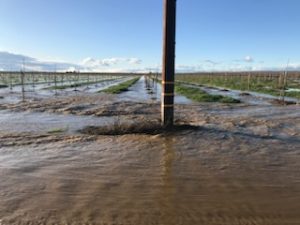Facing a second wet winter in a row, tree nut growers in California might want to adopt the Boy Scout motto “Be Prepared.”
Originator of the motto, Robert Baden-Powell declared the meaning to be always “in a state of readiness in mind and body to do your duty.”
Translated to tree nut production, “You want to be proactive with your orchard management. Plan ahead” Sebastian Saa, associate director of agricultural research for Almond Board of California, said. “It is more than likely an El Niño year will bring more precipitation and challenges, but there are actions growers can take to deliver good outcomes.”
A starting point for preparation would be a look back at impacts on orchards from the last winter and spring storms. Where water accumulated on orchard floors, where water entered orchards, what diseases affected tree health and how irrigation was initiated are all noteworthy observations. Being proactive means taking advantage of opportunities for groundwater recharge in orchards where possible, planting cover crops, planning disease control measures and adding soil amendments.
Willows-area walnut grower Leslie Nerli said the potential for another wet winter is already on her mind. While standing water was not an issue in her orchards last year, moving water delivered debris and orchard floors needed to be reworked. She said last year there was also erosion where ground was bare. This fall, she said she is allowing native vegetation to remain in those places and plans to remove burn piles of broken limbs out of the orchard before rain. Fungicide applications with phosphite are planned to prevent phytophthora.
Zack Raven, farm manager at Keenan Farms, said he plans to tackle orchard sanitation as soon as possible after the end of pistachio harvest.
“Get your zinc spray done, prune and mummy shake and spread,” Raven advised. He said it would also be smart to make ditches so rain runoff flows where you want it to go.
Soil amendment applications and preemergence herbicide sprays should also be timed appropriately. Finally, the initiation of irrigation should be considered.

Groundwater Recharge Opportunities
“It is important to have a two-way conversation with your water district,” Saa said. This is the first step toward taking advantage of groundwater recharge opportunities.
Questions to ask the district include if the location has access to surface water and if the soil is suitable for recharge or are there impermeable layers below the surface. Recharge methods must be evaluated, and some management changes may be necessary to perform recharge.
Methods include surface application to the orchard, below surface application or basin structures. With each, there are management considerations, and they require coordination between district and grower to achieve credit for water. Almond Board, in their groundwater recharge guidelines, reports using groundwater recharge to direct excess flows underground has been shown to be more economical than other storage methods. It also mitigates overdraft and supports SGMA implementation.
Cover Crops
The key word here is “infiltration.” Cover crops can improve soil health over time, but the plant roots also act as a conduit for water to permeate the soil and move downward. Cover crops are compatible with groundwater recharge, Saa said.
UC Davis studies show cover crops in orchards can increase soil water retention by increasing infiltration capacity and reducing surface runoff. In hillside topography, erosion can be reduced where there are permanent or annual cover crops compared to bare soil managed with traditional tillage. A study in Yolo County suggested nutrient and water runoff can be reduced where cover crops are planted.
Cover crops are generally planted in the November to January time frame and germinate over the winter when rain can encourage growth. Choosing the right mix of cover crop seed is important and Saa recommended discussing choices with a crop consultant. Cover crops can help reduce soil compaction by increasing structure and helping to improve soil water holding capacity. A good stand may also help accessing the orchard in wet conditions.
Disease Potential
Phytophthora and Botryosphaeria are two diseases triggered by rain. UC Plant Pathologist Themis Michailides said spores from the fungal disease Botryosphaeria are developed in late summer and spread by rain. Infections begin at the base of developing shoots and clusters.
Phytophthora or crown rot infections are more likely to kill young trees. Chronic infections in older trees can reduce growth. Saturated soil for more than 24 hours can lead to infections. Although almond rootstocks vary in susceptibility, none are resistant to this fungal disease. UC IPM guidelines recommend providing adequate drainage in areas that flood. Saa said Phytophthora prevention is important, and some growers may plan improving drainage in complicated areas and/or treat hotspots in consultation with their local farm advisor or PCA.
CCA John Post reported a fairly new material called Orondis is registered in walnuts and almonds. He said growers can also apply a phosphite spray to help control Botryosphaeria. Applications should be made as soon as nuts are shaken in walnuts.
Michailides said it is important to apply a fungicide in the spring to protect green tissue from infection. Botryosphaeria infections were on the rise last spring, he said, and have been increasing in recent years. Wet spring weather is conducive to infection and growers should anticipate applying fungicides and prepare their spray equipment.
Improving soil health is another avenue to protecting trees from disease. Saa said adding amendments to orchard soil will also help with water infiltration.
Irrigation Timing
Saa noted the first irrigation event would likely be a bit later than usual this spring, especially if El Niño brings cold/mild weather in early spring. In a nutshell, he said to be careful with starting your irrigation plan too soon!
“This is not a calendar decision,” he said, “You have to monitor soil moisture.” He said it is likely the start time will be later in the spring depending on orchard location.
Irrigation system and pump maintenance needs to occur between post-harvest and bloom. Pump time could be reduced if enough winter rain is received.












